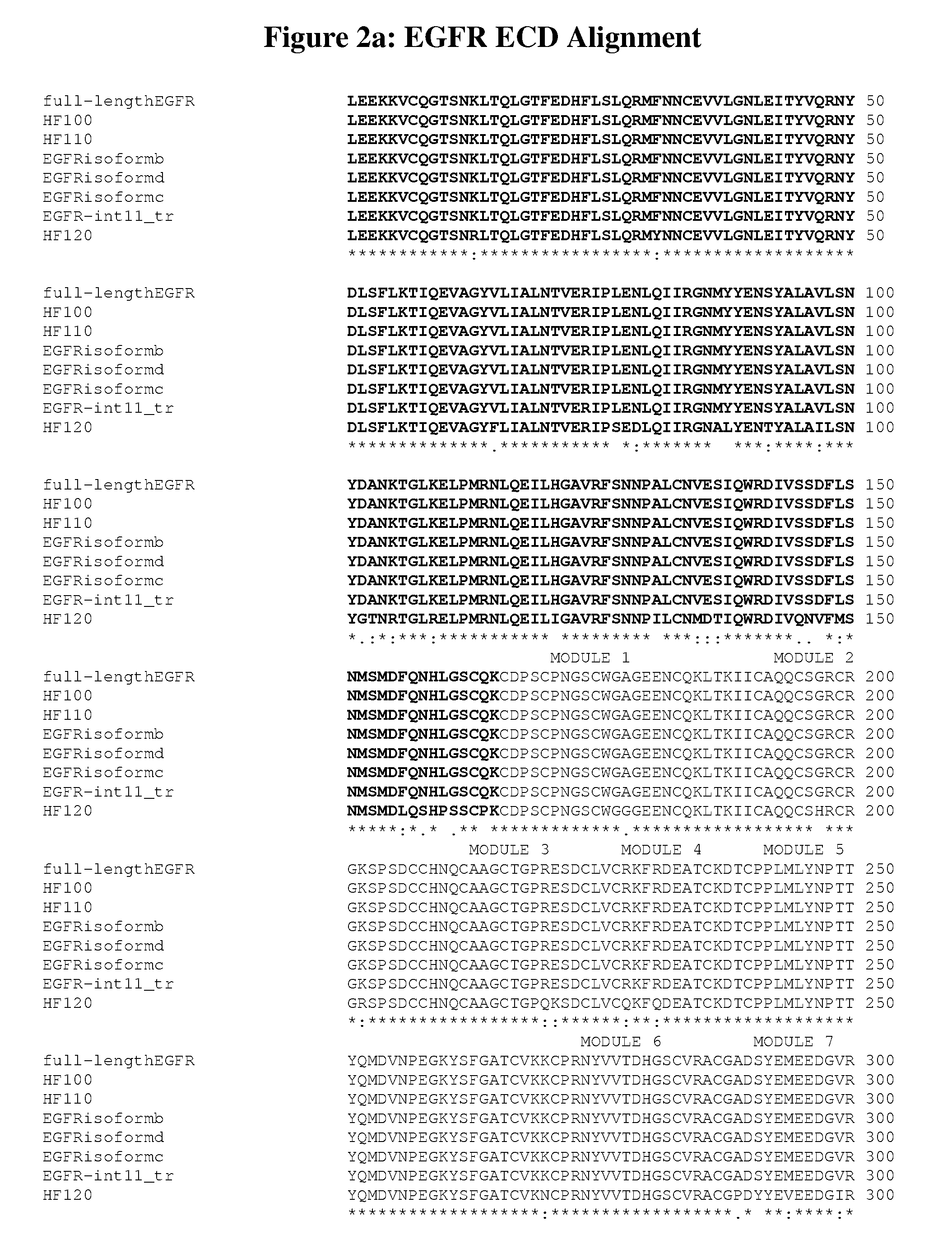Pan-cell surface receptor-specific therapeutics
a technology of pan-cell surface receptors and therapeutics, applied in the field of pan-cell surface receptor-specific therapeutics, can solve problems such as limitations on the effectiveness of anti-cancer effects
- Summary
- Abstract
- Description
- Claims
- Application Information
AI Technical Summary
Benefits of technology
Problems solved by technology
Method used
Image
Examples
example 1
Cloning of HER Extracellular Domains
[0740]Various HER derivatives containing all or part of the extracellular domain of a HER molecule were cloned and expressed.
A. Cloning HER ECD Derivatives
[0741]HER1-621 (SEQ ID NO:12) was cloned as follows: the extracellular domain (amino acids 1-621 of the amino acid sequence of the full-length HER1 receptor (obtained from Gail Clinton; SEQ ID NO: 2) was PCR amplified and subcloned into pcDNA3.1 Myc-His vector (Invitrogen; see also SEQ ID No. 161 for sequence of a pcDNA3.1 Myc-His) via KpnI-Xho1 restriction sites to generate pcDNA / HER1-621-myc-His vector.
[0742]HER3-621 (SEQ ID NO:26) was cloned as follows: the extracellular domain (amino acids 1-621 of the amino acid sequence of the full length HER3 receptor (see, SEQ ID NO:6) was PCR amplified and subcloned into pcDNA 3.1 Myc-His vector via KpnI-XbaI restriction sites to generate a vector designated pcDNA / HER3-621-myc-His vector.
[0743]Additional ECD derivatives were cloned. Their designations a...
example 2
HER-Fc Fusion Preparation and Protein Expression
[0747]A. Cloning of the Fc Fragment of human IgG1
[0748]The Fc fragment of human IgG1 (set forth in SEQ ID NO:167, and corresponding to amino acids Pro100 to Lys330 of the sequence of amino acids set forth in SEQ ID NO:163) was PCR amplified from a single strand cDNA pool using the forward and reverse primer pair:
5′ CCC AAA TCT TGT GAC AAA ACT ACT(SEQ ID NO: 49)C 3′5′ TTT ACC CGG GGA CAG GGA G 3′(SEQ ID NO: 50)
The PCR fragment was gel purified and subcloned into the pDrive cloning vector (Qiagen PCR cloning kit, Qiagen, Valencai Calif., SEQ ID NO:160) to generate pDrive / IgG1Fc.
B. Fusion of Fc to HER Extracellular Domains
[0749]HER1-621 / Fc (SEQ ID NO:40) was cloned as follows: the pcDNA / HER1-621-myc-His vector was restriction digested with XhoI and AgeI. The cut plasmid was purified using Qiagen gel purification kit (Qiagen). The human IgG1 Fc fragment was PCR amplified from the pDrive / IgG1Fc vector using the following primers:
5′ ATTA CT...
example 3
Purification of HER (HF) Derivatives and HER-Fc (HFD) Molecules
[0757]All HF molecules with a “T” suffix contain a C-terminal 6-histidine tail for metal affinity purification. All of these molecules were purified using Ni-affinity metal chromatography followed by preparative size-exclusion chromatography (SEC). First, conditioned medium (CM) containing a secreted HF molecule was clarified by centrifugation (30 min, 10K rpm) and then filtered (0.3 micron). Clarified CM was then concentrated 4× using a Pall tangential flow concentrator (Pall Corporation, Ann Arbor, Mich.) to bring the final CM volume to approximately 400 ml.
[0758]The CM was brought to 50 mM NaPO4 (pH 8.0) and 350 mM NaCl by the addition of 10× Ni-NTA loading buffer. The solution was then loaded at a flow rate of 0.6 ml / min onto a 1.5 ml nickle affinity metal chromatography column (Ni-NTA Agarose, Qiagen, Germany) pre-equilibrated with Buffer A (Buffer A: 50 mM NaPO4 (pH 8), 350 mM NaCl). After loading the column was wa...
PUM
| Property | Measurement | Unit |
|---|---|---|
| full-length | aaaaa | aaaaa |
| length | aaaaa | aaaaa |
| hydrophobic | aaaaa | aaaaa |
Abstract
Description
Claims
Application Information
 Login to View More
Login to View More - R&D
- Intellectual Property
- Life Sciences
- Materials
- Tech Scout
- Unparalleled Data Quality
- Higher Quality Content
- 60% Fewer Hallucinations
Browse by: Latest US Patents, China's latest patents, Technical Efficacy Thesaurus, Application Domain, Technology Topic, Popular Technical Reports.
© 2025 PatSnap. All rights reserved.Legal|Privacy policy|Modern Slavery Act Transparency Statement|Sitemap|About US| Contact US: help@patsnap.com



